Research and Development of Adjustable Discontinuous Pulse Width Modulation Method for Three-Phase Voltage Source Inverter
Abstract
1. Introduction
2. The Proposed Three-Phase Inverter Control Method
- unit 1 input—amplitude and angle of inverter output voltage vector;
- unit 6 input—inverter radiator temperature;
- unit 8 input—PWM frequency of inverter output voltage.
Tb2 = A · sin (β);
T0 = 1 − Tb1 − Tb2,
- equal to zero when the temperature of the inverter radiator is less than the threshold value;
- directly proportional to the difference between the threshold and current values of inverter radiator temperature when the temperature of the inverter radiator is above the threshold value.
- for sector 1—curves of phases A and C;
- for sector 2—curves of C and B phases;
- for sector 3—curves of phases B and A;
- for sectors 4, 5 and 6—similar to sectors 1, 2 and 3.
- equal to the positive value of inverter output phase voltage amplitude during the formation of a positive half-wave of inverter output phase voltage;
- equal to the negative value of inverter output phase voltage amplitude during the formation of a negative half-wave of inverter output phase voltage.
3. Simulation Model of the Proposed Control
4. Simulation Results and Discussion
4.1. Comparing the Performance of the Proposed ADPWM Method with CPWM
4.2. Comparing the Performance of the Proposed ADPWM Method with PCDPWM and NCDPWM
5. Conclusions
- testing the proposed ADPWM method using a three-phase voltage source inverter to verify the data obtained during the simulation;
- studies of the method operation as closed voltage circuit part.
Author Contributions
Funding
Conflicts of Interest
Abbreviations
| ADPWM | Adjustable discontinuous pulse width modulation |
| CPWM | Continuous pulse width modulation |
| DPWM | Discontinuous pulse width modulation |
| NCDPWM | DPWM strategy with clamping to negative bus bar the number of commutations |
| PCDPWM | DPWM strategy with clamping to positive bus bar the number of commutations |
| PWM | Pulse width modulation |
| SPWM | Sinusoidal pulse width modulation |
| SVPWM | Space vector pulse width modulation |
| THD | Total Harmonic Distortion |
References
- Abramov, B.I.; Derzhavin, D.A.; Churikov, A.M.; Novoselov, Y.B.; Suslov, M.; Shevyrev, Y.V. Instrumental studies of the electrical energy quality for oil field under conditions of widespread application of frequency-regulated electrical drives. Oil Ind. J. 2016, 1, 90–92. [Google Scholar]
- Hava, A.M.; Kerkman, R.J.; Lipo, T.A. A high-performance generalized discontinuous PWM algorithm. IEEE Trans. Ind. Appl. 1998, 34, 1059–1071. [Google Scholar] [CrossRef]
- Li, K.; Wei, M.; Xie, C.; Deng, F.; Guerrero, J.M.; Vasquez, J.C. Triangle Carrier-Based DPWM for Three-Level NPC Inverters. IEEE J. Emerg. Sel. Top. Power Electron. 2018, 6, 1966–1978. [Google Scholar] [CrossRef]
- Nguyen, T.D.; Hobraiche, J.; Patin, N.; Friedrich, G.; Vilain, J.P. A Direct Digital Technique Implementation of General Discontinuous Pulse Width Modulation Strategy. IEEE Trans. Ind. Electron. 2011, 9, 4445–4454. [Google Scholar] [CrossRef]
- Schonung, A. Static frequency changers with subharmonic control in conjunction with reversable variable speed AC drives. Brown Boveri Rev. 1964, 555, 577. [Google Scholar]
- Xue, Y.; Li, Y.; Zhang, J.; Lin, J.; Yang, J.T. Application and Simulation of SVPWM Control Techniques in Three-Phase PV Grid-Connected Inverter. Appl. Mech. Mater. 2013, 415, 81–88. [Google Scholar] [CrossRef]
- Asiminoaei, L.; Rodriguez, P.; Blaabjerg, F. Application of Discontinuous PWM Modulation in Active Power Filters. IEEE Trans. Power Electron. 2008, 4, 1692–1706. [Google Scholar] [CrossRef]
- Mukherjee, S.; Giri, S.K.; Banerjee, S. A modified DPWM scheme for capacitor voltage balancing in three level NPC traction inverter for electric vehicles. In Proceedings of the 2016 IEEE International Conference on Power Electronics, Drives and Energy Systems (PEDES), Thiruvananthapuram, India, 14–17 December 2016. [Google Scholar]
- Yang, Z.; Zeng, J.; Ren, Q.; Wu, L.; Liao, Z. A Semi Discontinuous PWM Method for Mitigating Oscillation in a Three-level Grid-tied PV Inverter. In Proceedings of the 2021 IEEE Energy Conversion Congress and Exposition (ECCE), Vancouver, BC, Canada, 10–14 October 2021. [Google Scholar]
- Zhang, Z.; Thomsen, O.C.; Andersen, M.A.E. Discontinuous PWM modulation strategy with circuit-level decoupling concept of three level neutral-point clamped (NPC) inverter. IEEE Trans. Ind. Electron. 2013, 60, 1897–1906. [Google Scholar] [CrossRef]
- Bruckner, T.; Bernet, S.; Guldner, H. The active NPC converter and its loss-balancing control. IEEE Trans. Ind. Electron. 2005, 52, 855–868. [Google Scholar] [CrossRef]
- Bhattacharya, S.; Mascarella, D.; Joos, G. Space-vector-based generalized discontinuous pulsewidth modulation for three-level inverters operating at lower modulation indices. IEEE J. Emerg. Sel. Top. Power Electron. 2017, 5, 912–924. [Google Scholar] [CrossRef]
- Sun, Y.; Du, C.; Liu, Q.; Zhu, B.; Wu, C. Research on Neutral-Point Balance Control of Three-Level Inverter Based on Hybrid DPWM. In Proceedings of the 2019 IEEE Conference on Industrial Electronics and Applications (ICIEA), Xi’an, China, 19–21 June 2021. [Google Scholar]
- McGrath, B.P.; Holmes, D.G.; Lipo, T. Optimized space vector switching sequences for multilevel inverters. IEEE Trans. Power Electron. 2003, 18, 1293–1301. [Google Scholar] [CrossRef]
- Choi, U.M.; Lee, H.H.; Lee, K.B. Simple neutral-point voltage control for three-level inverters using a discontinuous pulse width modulation. IEEE Trans. Energy Conv. 2013, 28, 434–443. [Google Scholar] [CrossRef]
- Beig, A.; Kanukollu, S.; AlHosani, K.; Dekka, A. Space vector based synchronized three-level discontinuous PWM for medium voltage high power VSI. IEEE Trans. Ind. Electron. 2014, 61, 3891–3901. [Google Scholar] [CrossRef]
- Hadj, M.E. DSP based random discontinuous space vector pwm for variable speed electrical drives. In Proceedings of the 2013 15th European Conference on Power Electronics and Applications (EPE), Lille, France, 2–6 September 2013. [Google Scholar]
- Anuchin, A.; Aliamkin, D.; Lashkevich, M.; Shpak, D.; Zharkov, A.; Briz, F. Minimization and redistribution of switching losses using predictive PWM strategy in a voltage source inverter. In Proceedings of the 2018 25th International Workshop on Electric Drives: Optimization in Control of Electric Drives (IWED), Moscow, Russia, 31 January–2 February 2018. [Google Scholar]
- Anuchin, A.; Briz, F.; Shpak, D.; Lashkevich, M. PWM strategy for 3-phase 2-level VSI with non-idealities compensation and switching losses minimization. In Proceedings of the 2017 IEEE International Electric Machines and Drives Conference (IEMDC), Miami, FL, USA, 21–24 May 2017. [Google Scholar]
- Ojo, O. The generalized discontinuous PWM scheme for three-phase voltage source inverters. IEEE Trans. Ind. Electron. 2004, 6, 1280–1289. [Google Scholar] [CrossRef]
- Yoo, S.; Lee, J.; Lee, K. Novel Discontinuous PWM Method of a Three-Level Inverter for Neutral-Point Voltage Ripple Reduction. IEEE Trans. Ind. Electron. 2016, 63, 3344–3354. [Google Scholar]
- Lee, J.-S.; Kwak, R.; Lee, K.-B. Novel Discontinuous PWM Method for a Single-Phase Three-Level Neutral Point Clamped Inverter with Efficiency Improvement and Harmonic Reduction. IEEE Trans. Power Electron. 2018, 11, 9253–9266. [Google Scholar] [CrossRef]
- Zu, G.; Zhu, X.; Yang, S. Using DPWM method to improve system efficiency of the machine drive system. In Proceedings of the 2019 22nd International Conference on Electrical Machines and Systems (ICEMS), Harbin, China, 11–14 August 2019. [Google Scholar]
- Lee, H.; Yoo, A.; Hong, C.; Lee, J. A carrier-based adjustable discontinuous PWM for three-phase voltage source inverter. In Proceedings of the 2015 IEEE Energy Conversion Congress and Exposition (ECCE), Montreal, QC, Canada, 20–24 September 2015. [Google Scholar]
- Gowri, K.; Reddy, T.B.; Babu, S.; Pulla, G. High-Performance Generalized ADPWM Algorithm for VSI Fed IM Drives for Reduced Switching Losses. Int. J. Recent Trends Eng. 2009, 5, 96–100. [Google Scholar]
- Pradeepa, S.; Kumar, S.; Prakash, G. Adoption of SVPWM Technique to CSI and VSI. In Proceedings of the 2018 3rd International Conference for Convergence in Technology (I2CT), Pune, India, 6–8 April 2018. [Google Scholar]
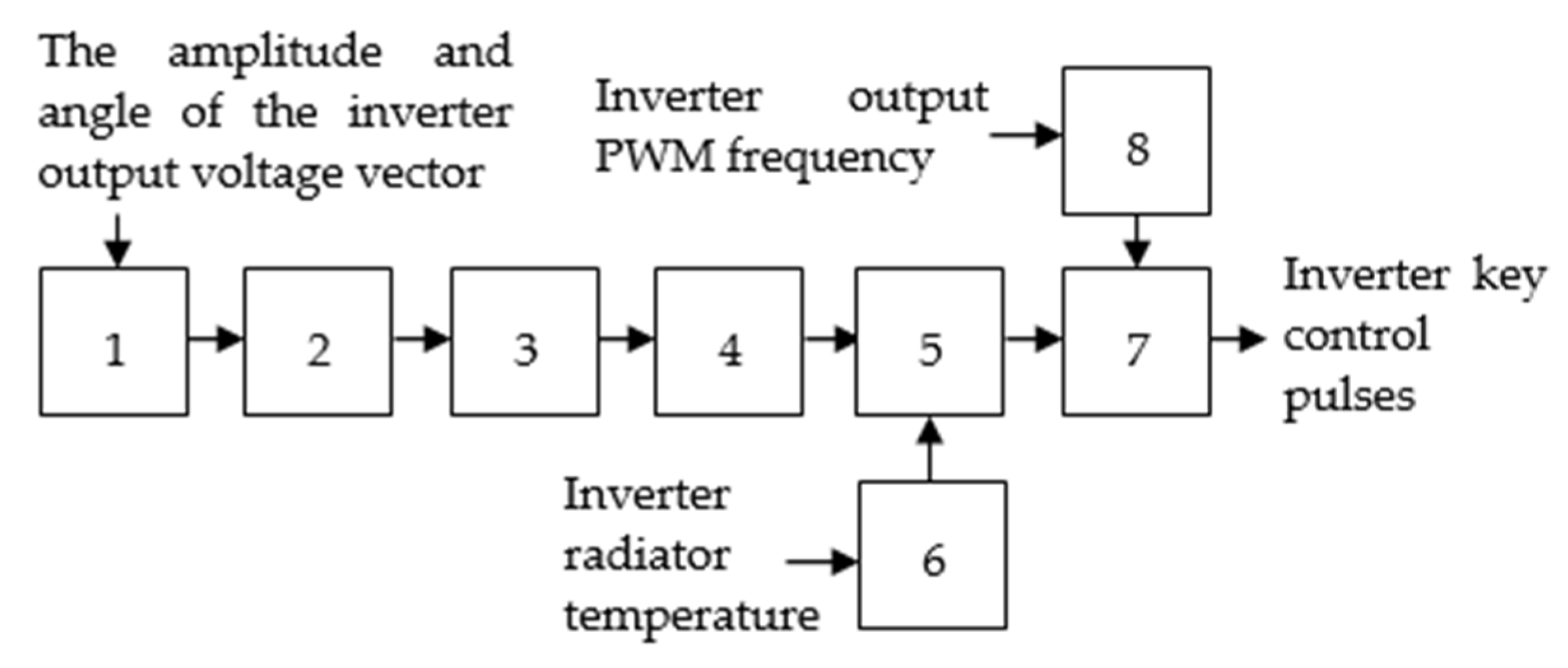
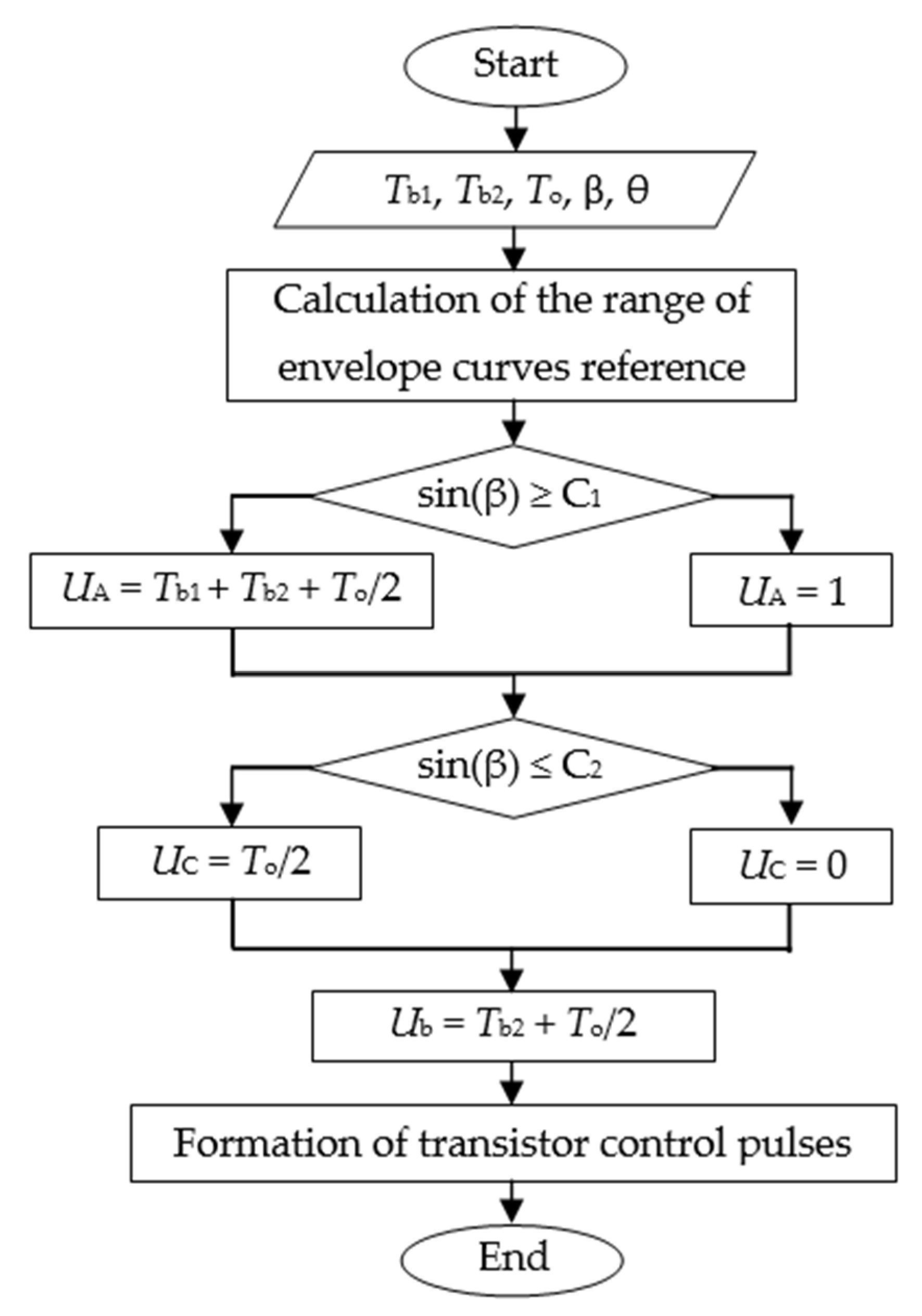
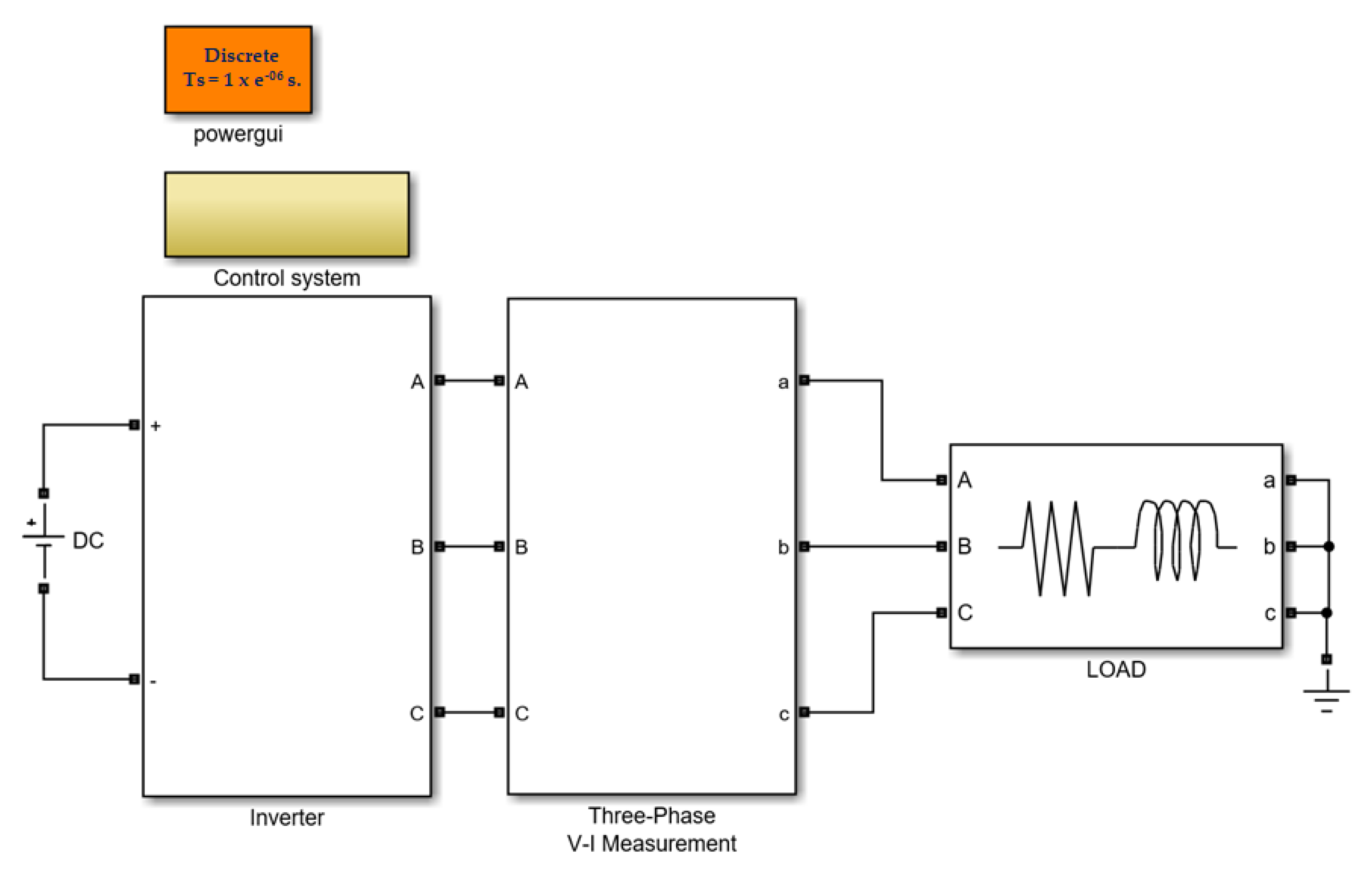

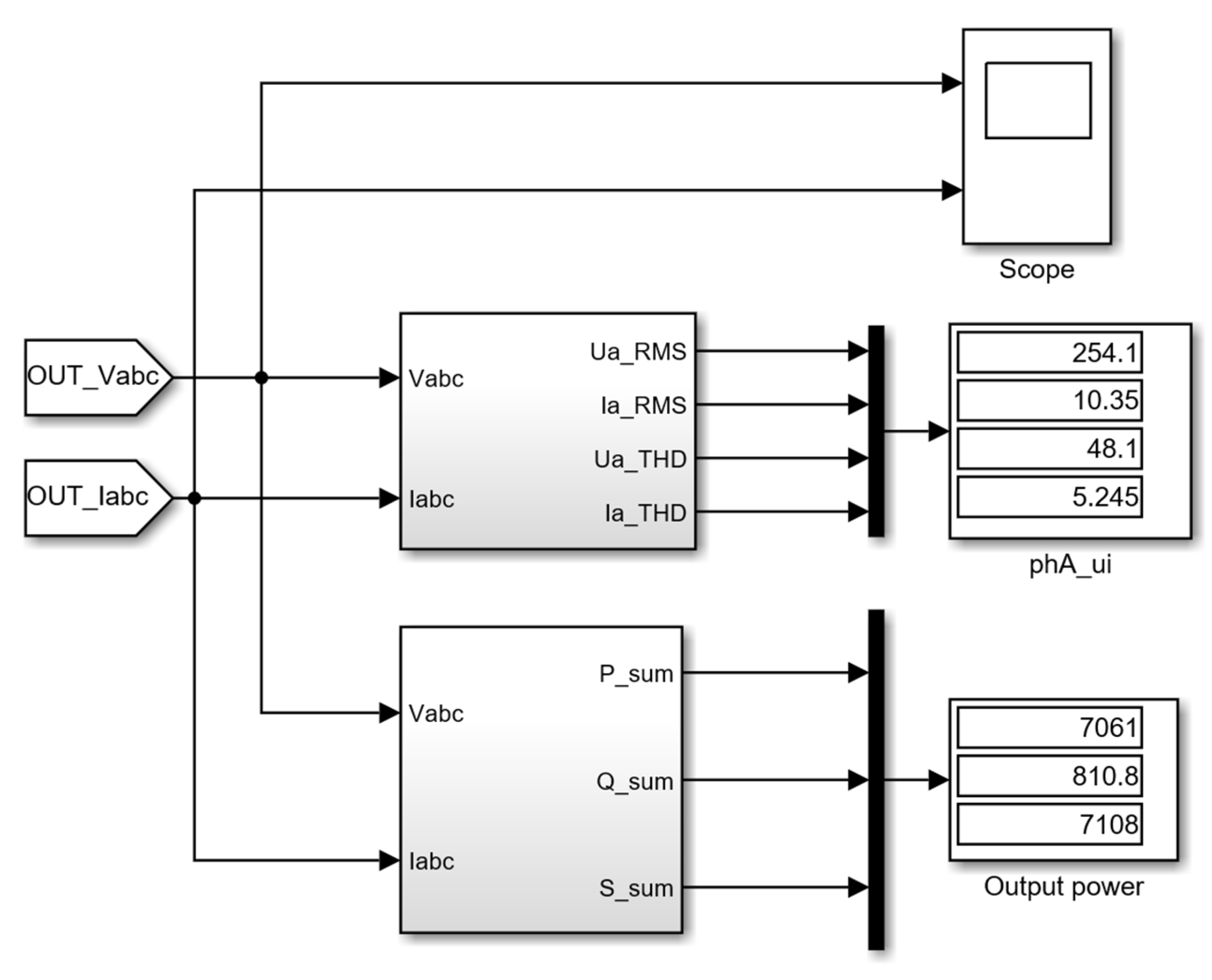



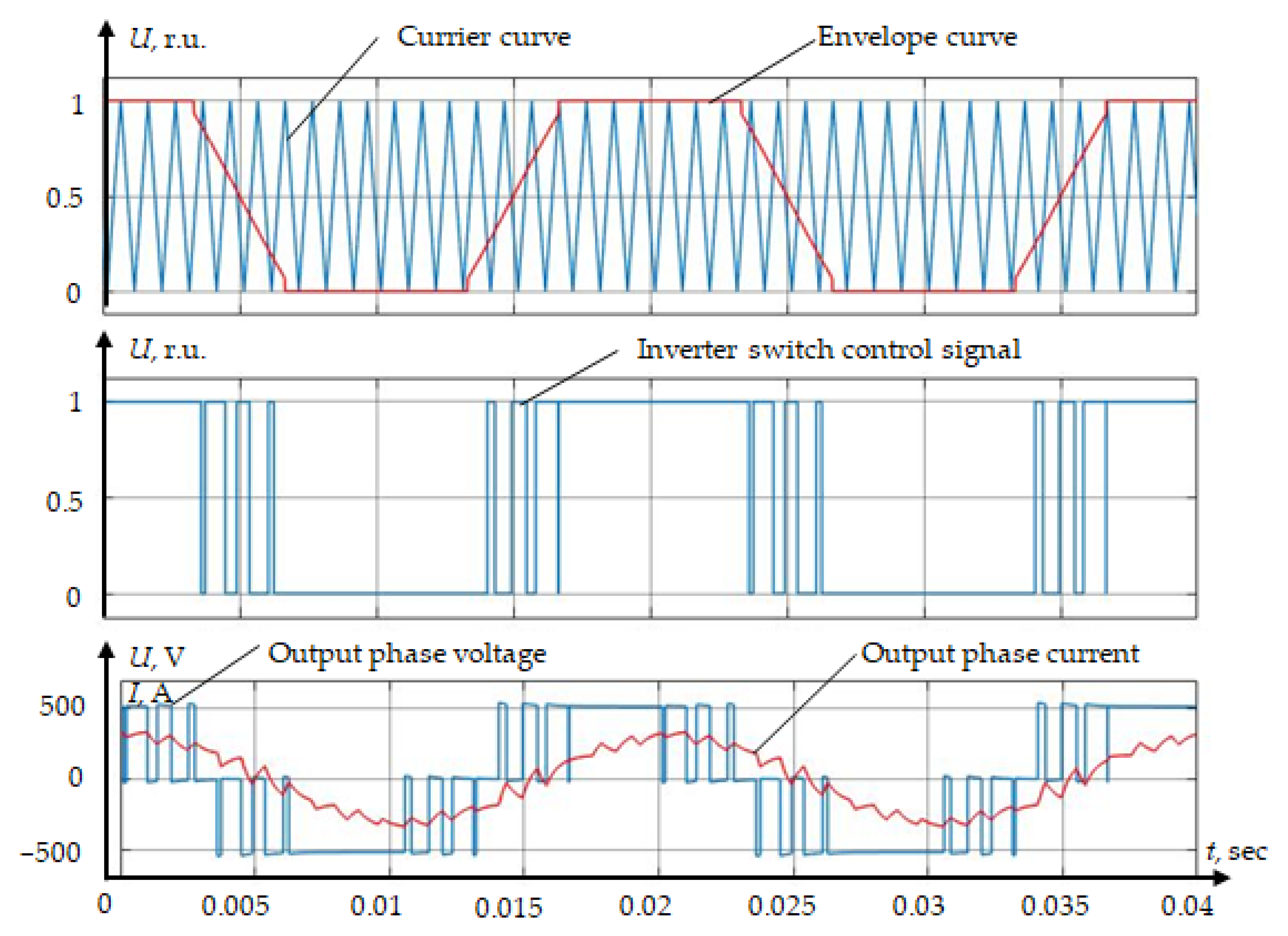
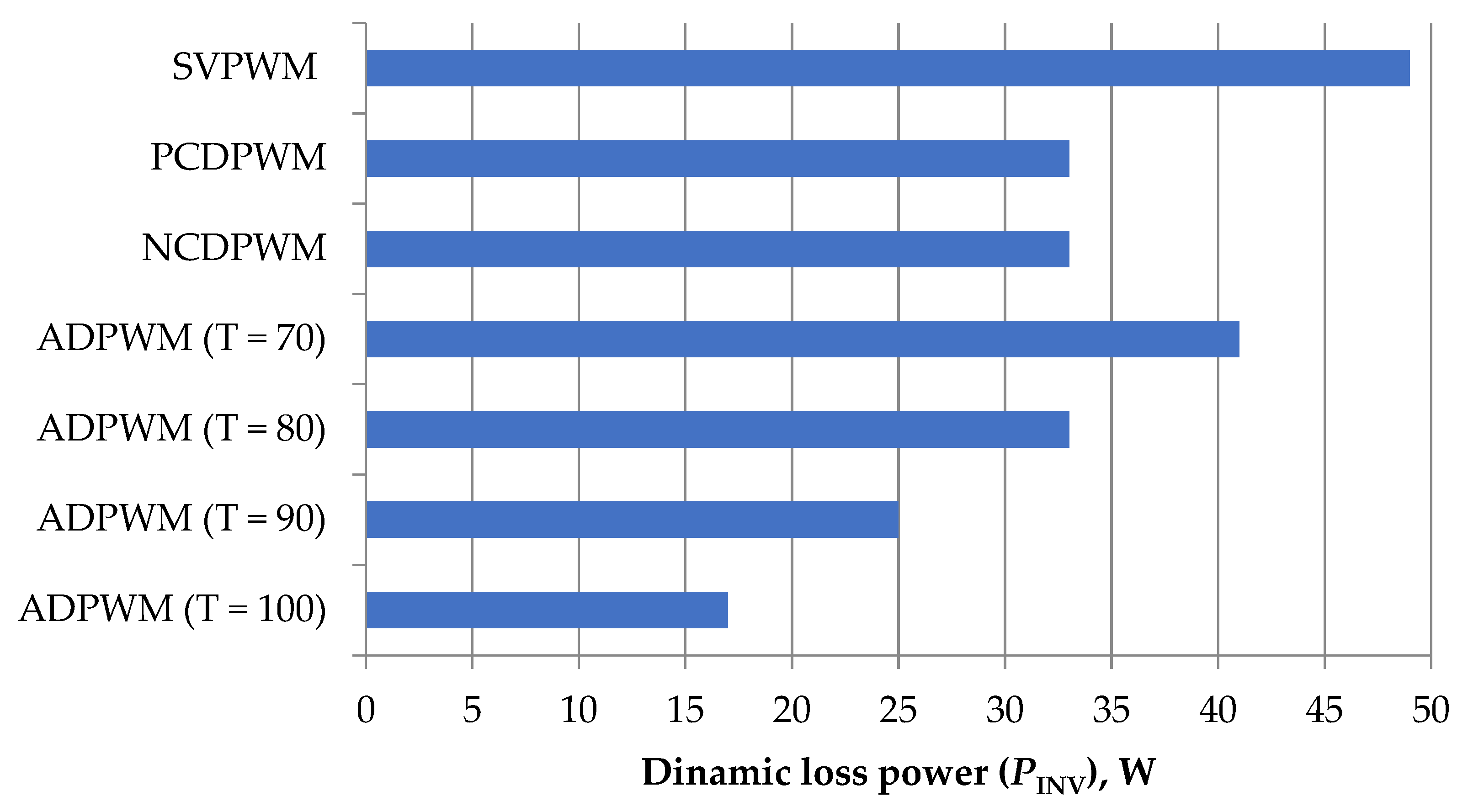
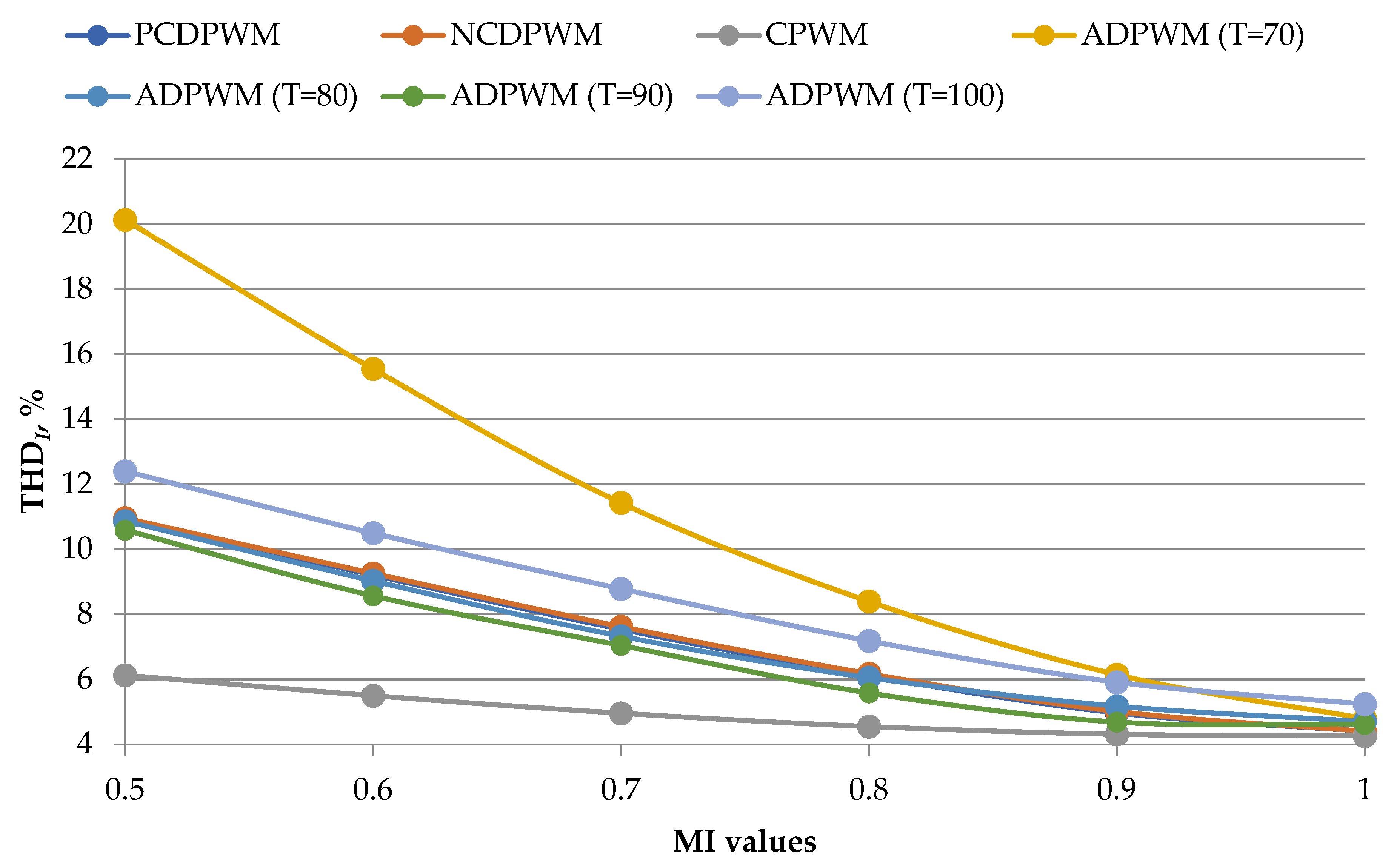
| CPWM | ADPWM (T = 70 °C) | ADPWM (T = 80 °C) | ADPWM (T = 90 °C) | ADPWM (T = 100 °C) | |
|---|---|---|---|---|---|
| N | 20 | 16 | 14 | 10 | 7 |
| URMS,B | 239.3 | 241.6 | 241.9 | 242.2 | 245 |
| IRMS,A | 209.1 | 214.1 | 214.6 | 215 | 218.8 |
| THDU,% | 54.72 | 51.38 | 51.09 | 51.03 | 49.55 |
| THDI,% | 12.79 | 12.75 | 12.78 | 12.89 | 13.25 |
| Psw,W | 12.6 | 10.08 | 8.82 | 6.3 | 4.41 |
| PCDPWM | NCDPWM | ADPWM (T = 60 °C) | ADPWM (T = 70 °C) | ADPWM (T = 80 °C) | ADPWM (T = 90 °C) | ADPWM (T = 100 °C) | |
|---|---|---|---|---|---|---|---|
| N | 53 | 53 | 79 | 66 | 53 | 40 | 28 |
| URMS,B | 176.7 | 174.6 | 175.7 | 199.5 | 219.2 | 236.6 | 254.7 |
| IRMS,A | 5.011 | 4.982 | 4.953 | 6.609 | 7.875 | 9.026 | 10 |
| THDU,% | 123.5 | 126.1 | 124.5 | 94.99 | 76.02 | 63.3 | 57.97 |
| THDI,% | 10.92 | 10.96 | 6.128 | 20.13 | 10.87 | 10.59 | 12.4 |
| PCDPWM | NCDPWM | ADPWM (T = 60 °C) | ADPWM (T = 70 °C) | ADPWM (T = 80 °C) | ADPWM (T = 90 °C) | ADPWM (T = 100 °C) | |
|---|---|---|---|---|---|---|---|
| N | 53 | 53 | 79 | 66 | 53 | 40 | 28 |
| URMS,B | 193.3 | 191.5 | 192.2 | 210.5 | 225.9 | 239.6 | 254.5 |
| IRMS,A | 5.992 | 5.964 | 5.93 | 7.287 | 8.322 | 9.248 | 10.06 |
| THDU,% | 105.1 | 107.4 | 106.3 | 85.11 | 70.57 | 60.42 | 56.09 |
| THDI,% | 9.208 | 9.262 | 5.498 | 15.55 | 9.031 | 8.569 | 10.5 |
| PCDPWM | NCDPWM | ADPWM (T = 80 °C) | ADPWM (T = 90 °C) | ADPWM (T = 100 °C) | ADPWM (T = 110 °C) | ADPWM (T = 120 °C) | |
|---|---|---|---|---|---|---|---|
| N | 53 | 53 | 79 | 66 | 53 | 40 | 28 |
| URMS,B | 208.4 | 207.1 | 207.3 | 220.6 | 231.5 | 242.2 | 253.8 |
| IRMS,A | 6.993 | 6.944 | 6.937 | 7.987 | 8.768 | 9.469 | 10.11 |
| THDU,% | 90.26 | 91.53 | 91.24 | 76.33 | 65.95 | 58.79 | 54.51 |
| THDI,% | 7.542 | 7.621 | 4.959 | 11.43 | 7.327 | 7.046 | 8.784 |
| PCDPWM | NCDPWM | ADPWM (T = 80 °C) | ADPWM (T = 90 °C) | ADPWM (T = 100 °C) | ADPWM (T = 110 °C) | ADPWM (T = 120 °C) | |
|---|---|---|---|---|---|---|---|
| N | 53 | 53 | 79 | 66 | 53 | 40 | 28 |
| URMS,B | 222.4 | 221.4 | 221.7 | 231.1 | 238.2 | 245.4 | 254 |
| IRMS,A | 7.967 | 7.962 | 7.931 | 8.702 | 9.237 | 9.713 | 10.19 |
| THDU,% | 76.94 | 77.94 | 77.62 | 67.3 | 60.45 | 55.62 | 52.44 |
| THDI,% | 6.116 | 6.177 | 4.551 | 8.398 | 6.055 | 5.584 | 7.185 |
| PCDPWM | NCDPWM | ADPWM (T = 80 °C) | ADPWM (T = 90 °C) | ADPWM (T = 100 °C) | ADPWM (T = 110 °C) | ADPWM (T = 120 °C) | |
|---|---|---|---|---|---|---|---|
| N | 53 | 53 | 79 | 66 | 53 | 40 | 28 |
| URMS,B | 235.9 | 234.9 | 235 | 240.9 | 244.5 | 248.4 | 253.9 |
| IRMS,A | 8.965 | 8.918 | 8.914 | 9.415 | 9.7 | 9.959 | 10.27 |
| THDU,% | 64.38 | 65.17 | 65.07 | 58.55 | 54.94 | 52.31 | 50.33 |
| THDI,% | 4.967 | 5.012 | 4.313 | 6.147 | 5.178 | 4.686 | 5.912 |
| PCDPWM | NCDPWM | ADPWM (T = 80 °C) | ADPWM (T = 90 °C) | ADPWM (T = 100 °C) | ADPWM (T = 110 °C) | ADPWM (T = 120 °C) | |
|---|---|---|---|---|---|---|---|
| N | 53 | 53 | 79 | 66 | 53 | 40 | 28 |
| URMS,B | 248.3 | 247.7 | 247.6 | 250.3 | 250.8 | 251.4 | 254 |
| IRMS,A | 9.939 | 9.902 | 9.896 | 10.13 | 10.18 | 10.21 | 10.35 |
| THDU,% | 52.49 | 53.01 | 53.04 | 49.9 | 49.31 | 48.97 | 48.18 |
| THDI,% | 4.401 | 4.403 | 4.263 | 4.79 | 4.7 | 4.618 | 5.241 |
Publisher’s Note: MDPI stays neutral with regard to jurisdictional claims in published maps and institutional affiliations. |
© 2022 by the authors. Licensee MDPI, Basel, Switzerland. This article is an open access article distributed under the terms and conditions of the Creative Commons Attribution (CC BY) license (https://creativecommons.org/licenses/by/4.0/).
Share and Cite
Dar’enkov, A.; Sokolov, V.; Sluzov, A.; Berdnikov, I.; Shalukho, A. Research and Development of Adjustable Discontinuous Pulse Width Modulation Method for Three-Phase Voltage Source Inverter. Energies 2022, 15, 7463. https://doi.org/10.3390/en15207463
Dar’enkov A, Sokolov V, Sluzov A, Berdnikov I, Shalukho A. Research and Development of Adjustable Discontinuous Pulse Width Modulation Method for Three-Phase Voltage Source Inverter. Energies. 2022; 15(20):7463. https://doi.org/10.3390/en15207463
Chicago/Turabian StyleDar’enkov, Andrey, Victor Sokolov, Anton Sluzov, Ivan Berdnikov, and Andrey Shalukho. 2022. "Research and Development of Adjustable Discontinuous Pulse Width Modulation Method for Three-Phase Voltage Source Inverter" Energies 15, no. 20: 7463. https://doi.org/10.3390/en15207463
APA StyleDar’enkov, A., Sokolov, V., Sluzov, A., Berdnikov, I., & Shalukho, A. (2022). Research and Development of Adjustable Discontinuous Pulse Width Modulation Method for Three-Phase Voltage Source Inverter. Energies, 15(20), 7463. https://doi.org/10.3390/en15207463






